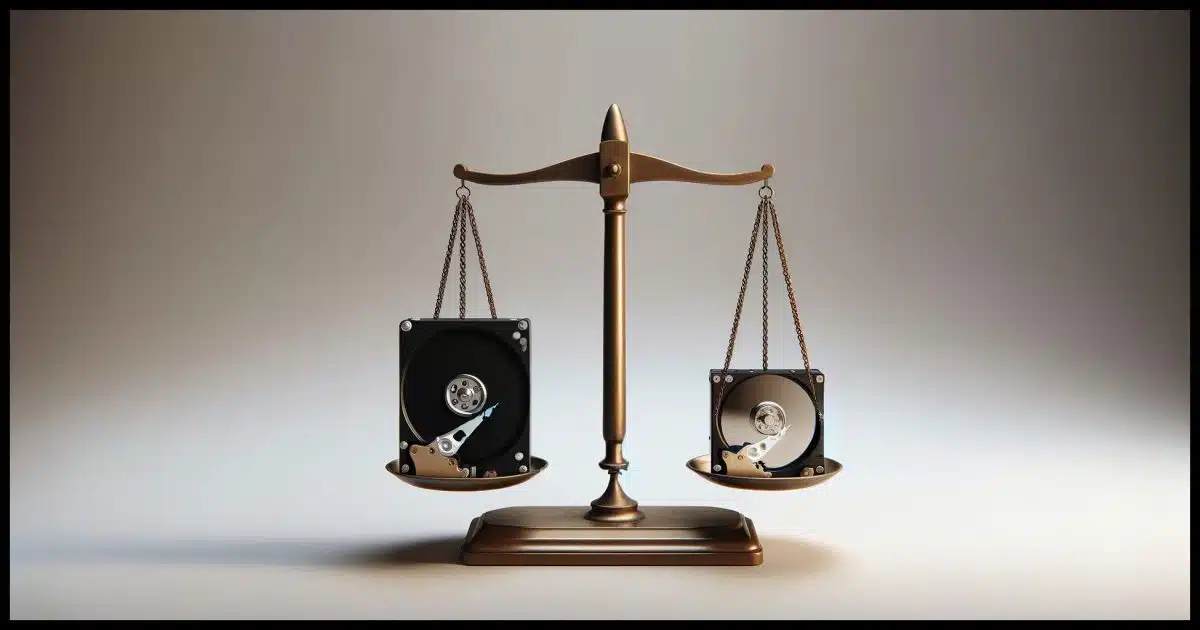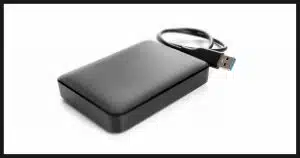The landscape keeps changing.

Can I make a specific recommendation? No.
The problem is that the industry is constantly changing in fundamental ways. Often it seems those changes happen immediately after I make a recommendation!
Instead of specific recommendations, I’ll discuss some of the characteristics of external drives and help you think about what you need.
Become a Patron of Ask Leo! and go ad-free!

External hard drives
When choosing an external hard drive, consider physical size (for portability, 2½-inch drives travel well), speed (5400 RPM is common for durability, 7200 for speed), and capacity (2TB minimum these days). Reliability varies, and manufacturers seem to cycle from good to bad and back again. Focus on your needs: size of backups, number of backups, additional uses, and, of course, your budget. Backing up is crucial regardless of drive specifics.
Physical size: 2½ inches vs. 3½ inches
If you want something portable, 2½ inches is nice. I have several 2½-inch drives. They are a little bit wider than that when they’re in their enclosure. Most don’t even require additional power.
I like having a backup drive with me when I’m out and about. When I’m flying, I have my laptop with me and the external drive in my checked bag. If I lose one, I still have the other. But even when I’m just driving around and traveling light, I throw an external drive in my backpack to have something to back up to at the end of every day, depending on how much work I’ve been doing.
3½-inch drives can be faster or have larger capacity. They’re good if you are looking for something that will sit next to your computer all day, as they often require an external power supply.
Speed: 5400 vs. 7200 RPM
When it comes to internal or primary drives, I do shop for faster rotation speeds. But for backing up, speed isn’t that big of a deal. I rarely check RPM (Revolutions Per Minute) when it comes to external drives. I couldn’t tell you what my external drives’ rotation speeds are.
What we’re talking about here is how fast the hard disk inside that drive spins: either 5400 RPM or 7200 RPM. There are internal drives that run at 10,000 RPM, but external drives generally run at slower speeds.
Laptop drives, which are designed to be a little bit more rugged, tend to be slower and smaller. They are often designed to run at 5400 RPM to increase their hardiness as portable devices. If speed matters to you, you might consider a faster drive, which might be a physically larger drive.
Capacity
This characteristic changes the fastest. When this article was first written, I recommended a terabyte at a minimum. Nowadays that seems small, and current external HDDs range from 2TB to 16TB or more.
You may be able to simplify your decision by asking yourself four questions.
- How big are my backups? (If you’re doing image backups, ballpark two-thirds of the actual disk space used on the disk you’re backing up.)
- How many backups do I want to keep?
- Am I going to use the drive for anything other than backups?
- How much am I willing to pay? (Larger drives are a bit more expensive.)
The primary 1TB drive that I want to back up has 400GB of data, though it varies quite a bit. I want to keep at least three months of backups, so that would (very roughly) be a terabyte of storage minimum. If I have a 2 TB drive, that means I can keep several backups for a while, which can be useful. Alternately, what I like to do with backups is keep a complete, full image backup once a month with daily incrementals. That can add up to a lot of disk space.
Since I also use the external drive for other things, I overcompensated and bought a 5TB external drive.
Brands
Brand is the unanswerable question because it changes so often.
I’ve observed drive quality to be cyclical over the years. Today, for example, I happen to gravitate towards Seagate drives. But Seagate drives haven’t always been the drives to get. There are several other manufacturers of hard drives. One of them is better for a while, then another is better for a time. On top of that, many brands have consolidated over the years, so different brands may deliver the same hardware.
Most recently I purchased a G-Technology drive, which is an intermediary company, so I’m not sure what drive is in the box. G-Technology is known for selling high-reliability, high-performance drives, so I’m assuming they’re making a reasonable choice on my behalf. I have two (another has been connected to my Mac Pro for many years), and they’ve both been rock solid.
SSDs?
Yes, there are external SSDs (Solid State Drives) now. You can use them the same way you’d use any external drive. The quality of SSDs has increased to the point that they’re almost as as reliable over time as traditional spinning-platter HDDs.
I don’t recommend them in general for one reason: they’re typically a waste of money. SSD technology is faster than HDD, but you won’t notice that advantage when using a USB connection. And they’re generally pricier per terabyte. My preference is to spend the same money for greater capacity in an HDD.
The only place external SSDs make sense is when traveling. Since they have no moving parts, they’re more resilient to the slings and arrows of outrageous baggage handling.
Do this
Above all, back up. Any drive — internal or external, from any manufacturer — can fail catastrophically and without warning at any time.
If you’re using an external drive to back up your data, that’s great, because you still have the original on the drive you’re backing up.
If you’re using an external drive to store data, make sure you back that data up somewhere else. If it’s in only one place, it’s not backed up.
Subscribe to Confident Computing! Less frustration and more confidence, solutions, answers, and tips in your inbox every week.





I’ve used both Western Digital and Seagate hard drives and rarely have had issues with either brand. Lately, like Leo, I’m using mostly Seagate drives because of pricing and I have had good results with their customer service when I did have problems. I have a couple of 2.5″ portable drives that are over 5 years old that are still working well.
Lots of good advice but remember you may not want to put all of your eggs(backups) in one basket. I alternate between two drives so that if one drive fails(think of Murphy’s Law) you have another that will allow you to recover to at least a very recent point. True, some backup routines might be too complicated for this. But if your backups are simple, this might be glad you used two drives.
That’s why Leo recommends the 3-2-1 backup method.
I keep a 1TB external SSD drive connected to both of my laptop PCs (one for each), and I have a 2TB internal SSHD drive on my desktop PC. I used to back up all three devices, but I stopped doing so on my laptops because I use them, basically, as satellites for my desktop. Since I store my important data/files on OneDrive, and access them from all three computers, I have set up my desktop PC to store all my OneDrive data locally too, so it’s backed up to my 2TB internal drive when backups are performed. Since neither of my two laptop PCs store any important data locally, I see no need to back them up.
I use a weekly differential backup regimen, in which a backup set consists of one full image backup, created every Monday, and six differential image backups, created every Tuesday through Sunday. I keep four image sets, so I can return the system to the state it was in on any of the past twenty-eight days, or recover data from any day during that same time period.
As for external drives, on my primary laptop PC, I use a 2TB WD-Elements SSD USB3 drive. It has performed well for several years, and when the time comes, I’ll consider replacing it with a newer version, but only after doing my due diligence/research.
This is how I handle system backups, and a hint about the hardware I use, but you should do your own research to get the best deal on the most appropriate drive for your needs, then consider your need when developing your backup regimen. What works for me may not be right for you.
Ernie (Oldster)
If I didn’t perform system image and incremental backups, I wouldn’t lose any data because all of my personal files are on OneDrive and my emails are synchronized via backups. All of my contacts and appointments are managed on Google. BUT I still use system image backups on all my computers. It’s easy, secure and the two times I’ve had to restore from an image backup, it only took a couple hours while I went shopping. I could have restored from OneDrive and the installation media, but it would have taken several hours of hands on installation and restoring settings, not to mention that it takes several days or weeks before you’ve tweaked all your settings. Restoring from a system image runs by itself with no need for intervention. Even if you only back up your sattelite computers once a week, you can get your system back much quicker.
I use HD docking stations. They can take either 2.5 inch or 3.5. Swapping the HD in or out is a breeze and the brand choice is yours.
I do photo and video, so as you might imagine, my storage needs keep growing and growing. When I download files from the camera(s), before erasing the cards, I have the files on two drives. Here’s where I may depart from practices: I have, at the moment, 2 – 3TB drives, a 4 TB, a 5 TB, and my main data drive, a 12 TB. Nothing but programs go on my system drive, and I have 2 – 1TB disk drives that alternate backups for the system SSD. Once I have edited and delivered the photo/video, depending on which and which client, I often delete one backup. Long-term clients, for which I may access the data drives more, usually have two copies, plus I archive raw photos and footage on separate older drives. Oh, and cloud backups too.
I have found most drives reliable; of course, I always buy 5400 RPM drives because for external drives the transfer limit is more likely the USB interface. I have a wide variety: Seagate and WD, but also Toshiba, Hitachi, and Maxtor. If I have a drive more than 3 years, I’m likely to have outgrown it, my 12TB needs replacing. No magic insights, just buy known manufacturers from reputable suppliers.
“No magic insights, just buy known manufacturers from reputable suppliers.” That’s my policy, but I also check trustworty reviews from reputable websites befor purchasing.